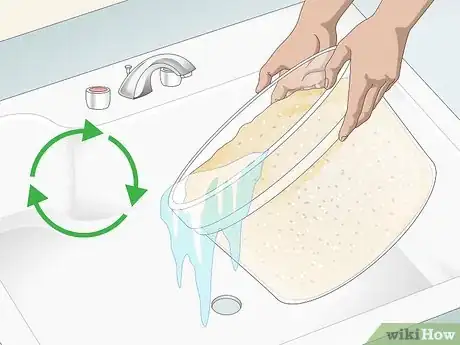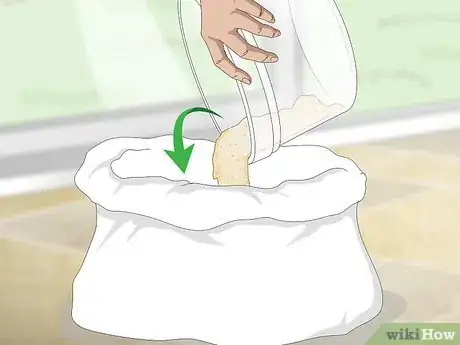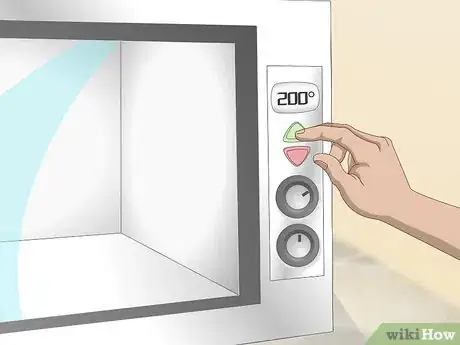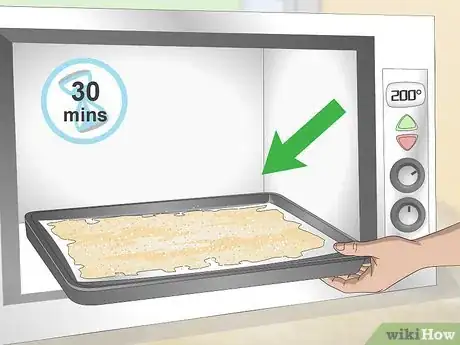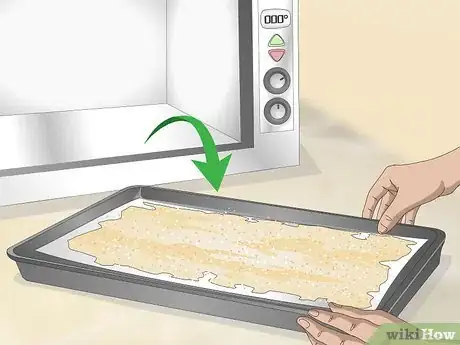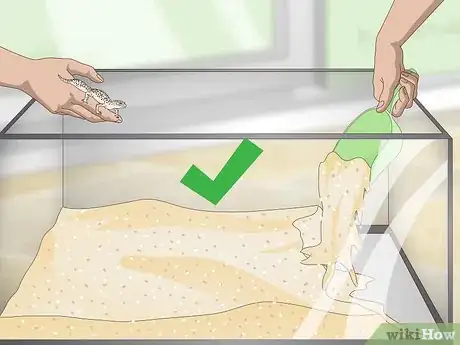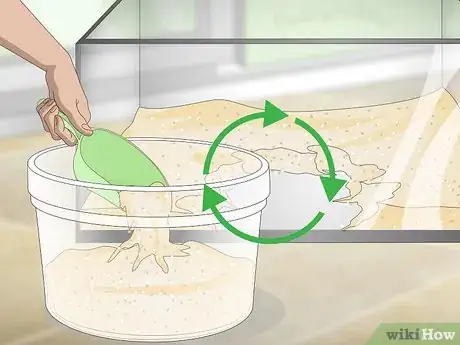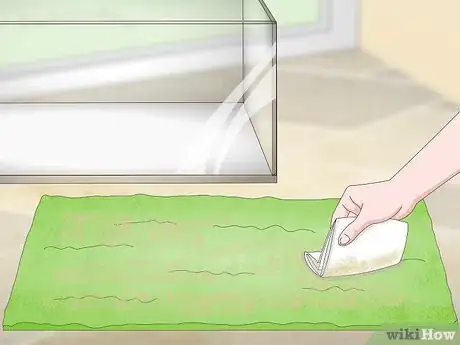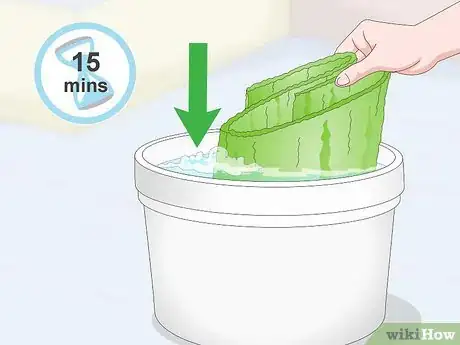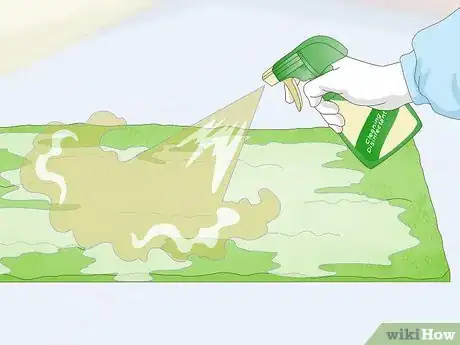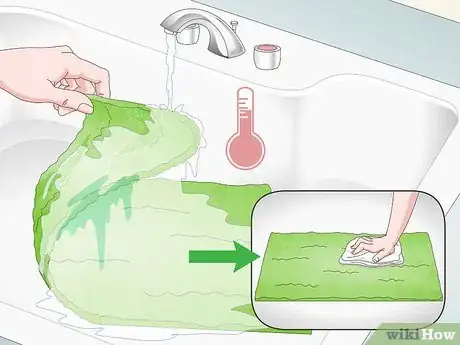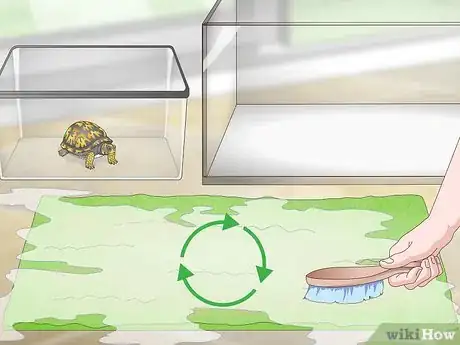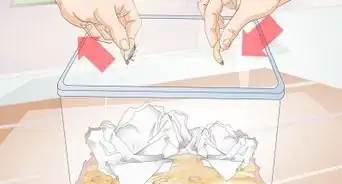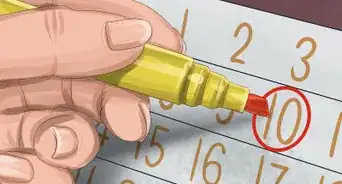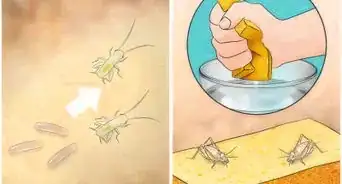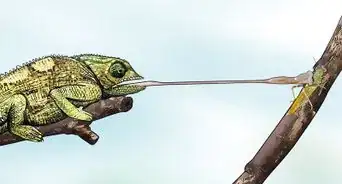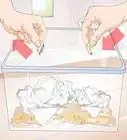This article was co-authored by wikiHow Staff. Our trained team of editors and researchers validate articles for accuracy and comprehensiveness. wikiHow's Content Management Team carefully monitors the work from our editorial staff to ensure that each article is backed by trusted research and meets our high quality standards.
There are 7 references cited in this article, which can be found at the bottom of the page.
This article has been viewed 32,572 times.
Learn more...
If you have a pet reptile, you know that keeping its habitat clean is very important to its overall health. Since reptile tanks build up harmful bacteria and parasites over time, part of keeping a clean habitat is ensuring that the substrate on the bottom of the terrarium is clean. If you have a terrarium liner at the bottom of that habitat, all you have to do is scrub the liner clean. If you have sand instead, you have to wash it and bake it in the oven in order to clean it.
Steps
Washing and Baking Sand
-
1Put your reptile in a safe enclosure before you begin cleaning the sand. Make sure this secondary container is clean and secure enough that your pet won’t escape. It will only be in this enclosure for about 2 hours, so you should only worry about the bare necessities here.[1]
- For instance, you don’t have to worry about putting food and water or clean substrate in this holding container, since your reptile will only be there for a short while.
-
2Move the sand from your reptile’s habitat to a 5 US gal (19 L) bucket. Use a small scoop to transfer the sand over in small batches to avoid having to lift up your reptile’s terrarium. Pour the sand into the bucket through a sand sifter to remove some of the larger pieces of debris right away.[2]
- If you don’t have a sand sifter, you can also use a colander with tiny holes to strain the sand.
- You can buy a sand sifter at most mass retailers.
Advertisement -
3Pour water and bleach into the bucket, then stir. Fill the bucket with enough water so that it’s nearly full, but leave enough room at the top so that you can stir the water without spilling it. Then, add 1.75 fluid ounces (52 mL) of bleach to the water. Use a large wooden spoon to stir the sand at the bottom of the bucket and sift out the dirt and debris in the substrate.[3]
- When you stir the sand, feces, debris, molted skin, and food waste will all float to the top of the bucket, leaving much cleaner sand on the bottom.
- For best results, allow the sand to “soak” in the bleach water for 3 minutes before you stir it.
-
4Dump the bleach water out of the bucket and repeat this process twice. Pour all of the dirty water out of the bucket, then replace it with another mixture of water and 1.75 fluid ounces (52 mL) of bleach. Stir the sand in the bucket to clean it and repeat.[4]
- Overall, you should go through this stirring process at least 3 times.
-
5Pour the wet sand into a pillowcase or flour sack towel. This will partially dry the sand before you bake it. Make sure whatever material you use is clean to avoid getting the sand dirty again.[5]
- Alternatively, you can also spread the wet sand out on a clean tarp to allow it to air dry if you don’t have a pillowcase or flour sack towel.
-
6Preheat the oven to 200 °F (93 °C). You may use a higher temperature to heat your sand faster, but 200 °F (93 °C) is a safe and reliable temperature for this process. It should take about 15 minutes for your oven to preheat.[6]
-
7Pour the sand onto a baking tray lined with aluminum foil. Use a large cookie sheet or baking dish if you don’t have a baking tray. Pour the sand slowly and spread it out to be as thin as possible on the tray.[7]
- You can also use parchment paper if you don’t have aluminum foil.
-
8Place the sand in the oven and bake it for 30 minutes. Baking the sand will not only dry it, but will also kill off any bacteria that wasn’t removed during the washing process. If the sand isn’t completely dry after 30 minutes, leave it in for an additional 15 minutes.[8]
- If the sand still isn’t dry, give it another 15 minutes. Although you can’t really “overcook” your sand, you shouldn’t have to bake it for more than an hour at most.
-
9Take the sand out of the oven and let it cool. Use oven mitts to safely remove the sand from the oven, as it will be very hot. Leave it to cool for at least an hour before placing it back in your terrarium.[9]
- Make sure the sand has completely cooled before putting it back in your terrarium. You don’t want to accidentally burn your pet reptile!
-
10Put the sand and your reptile back in the terrarium. Put 2 to 3 inches (5.1 to 7.6 cm) of sand in the terrarium first, followed by any materials you had to take out of the terrarium when you began. If you have a sensitive reptile, you may need to warm up the sand a little bit with a heating pad or heating lamp before reintroducing your pet to the habitat.[10]
-
11Repeat this process on a weekly basis. Reptile habitats need to be deep cleaned every week to keep your pet healthy. If you don’t want to go through the process of cleaning the sand again, replace it with new sand to provide your reptile with clean substrate.[11]
Disinfecting Terrarium Liners
-
1Take your reptile out of its habitat and put it in a secure enclosure. Be sure to put it in a clean enclosure that it won’t be able to escape out of. Don’t worry about putting food, water, or substrate in this container, since your reptile will only be in this enclosure for a short while.[12]
-
2Remove the liner from the habitat and wipe it off with paper towels. Use the paper towel to clean off any large pieces of feces and soak up any urine on the surface of the terrarium liner. Wipe this waste into a large garbage bag and tie the bag once you’re done.
- This cleaning method works with any type of absorbent, non-abrasive reptile carpet.
- To be safe, be sure to wear a mask and rubber gloves when handling your pet’s waste.
-
3Soak the liner in a bucket of soapy water for 15 minutes. Mix 1 tablespoon (15 mL) of dish soap into a large bucket of hot water. Then, place the terrarium liner in the bucket, making sure it’s completely submerged under the water.
- Since most reptile carpets are pretty flexible, use a bucket that is as tall as your liner is wide. That way, you can wrap the liner and soak it on its side.
-
4Scrub the liner gently to clean it, then rinse off the soapy residue. Use a brush with soft bristles to clean both sides of the terrarium liner, scrubbing in short circular motions. Don’t push down too hard with the brush, as you may accidentally damage the liner.
- Be sure to clean both sides of the terrarium liner with the brush and not just the top surface!
-
5Use reptile-safe disinfectant to disinfect both sides of the liner. Apply this disinfectant to kill the bacteria, viruses, and fungi that the soapy water wasn’t able to remove. Be sure to closely follow the manufacturer’s instructions to ensure you’re applying the disinfectant correctly.
- For maximum safety, wear rubber cleaning gloves and safety goggles when working with disinfectant.
- You can buy reptile-safe disinfectant from any pet store that sells reptile supplies.
-
6Rinse the liner with hot water and dry it with a clean towel. Be sure to rinse the terrarium liner very thoroughly to remove all traces of the dish soap. Make sure the liner is completely dry before putting it back in the terrarium.[13]
- Don’t rely on air drying the terrarium liner, since that will just make your reptile have to wait longer before being returned to its habitat.
-
7Put the liner and your reptile back in the habitat. Lay the liner down first and replace the food bowl, water bowl, and any other decor you took out of the tank. Keep an eye on your reptile after you put it back in its tank to make sure it doesn’t have any negative reaction to the liner.[14]
- Be on the lookout for signs of illness in your reptile, such as lethargy, loss of appetite, or a darkening of the skin. These may all indicate that your reptile is having a negative reaction to the newly cleaned liner.
-
8Repeat this process every week. The carpet in your reptile’s habitat will need to be cleaned on a weekly basis in order to keep your pet healthy. If your terrarium liner begins to show signs of damage, or you simply don’t want to clean it again, buy a replacement carpet to ensure your reptile’s habitat remains clean.[15]
References
- ↑ http://www.reptileknowledge.com/news/how-to-clean-a-snake-cage-quickly-and-easily/
- ↑ https://www.youtube.com/watch?v=4pYYtNPoWVw#t=01m
- ↑ https://www.youtube.com/watch?v=4pYYtNPoWVw#t=02m15s
- ↑ https://www.youtube.com/watch?v=4pYYtNPoWVw#t=47s
- ↑ https://www.youtube.com/watch?v=4pYYtNPoWVw#t=02m38s
- ↑ https://animals.mom.me/how-to-clean-a-reptile-tank-12485520.html
- ↑ https://animals.mom.me/how-to-clean-a-reptile-tank-12485520.html
- ↑ https://animals.mom.me/how-to-clean-a-reptile-tank-12485520.html
- ↑ https://animals.mom.me/how-to-clean-a-reptile-tank-12485520.html
- ↑ https://animals.mom.me/how-to-clean-a-reptile-tank-12485520.html
- ↑ https://animals.mom.me/how-to-clean-a-reptile-tank-12485520.html
- ↑ http://www.reptileknowledge.com/news/how-to-clean-a-snake-cage-quickly-and-easily/
- ↑ http://www.reptilesmagazine.com/Reptile-Health/Habitats-Care/Cleaning-Reptile-Cages/
- ↑ http://www.reptilesmagazine.com/Reptile-Health/Habitats-Care/Cleaning-Reptile-Cages/
- ↑ https://animals.mom.me/how-to-clean-a-reptile-tank-12485520.html



